Impact of Media Stereotypes on Support for Policies Harming Muslims
VerifiedAdded on 2023/01/19
|9
|2389
|39
AI Summary
This study examines the impact of media stereotypes on Americans' support for policies that harm Muslims. It finds that exposure to news portraying Muslims as terrorists increases support for military action and civil restrictions. The study highlights the role of media in shaping attitudes and policies towards Muslims.
Contribute Materials
Your contribution can guide someone’s learning journey. Share your
documents today.

Secure Best Marks with AI Grader
Need help grading? Try our AI Grader for instant feedback on your assignments.
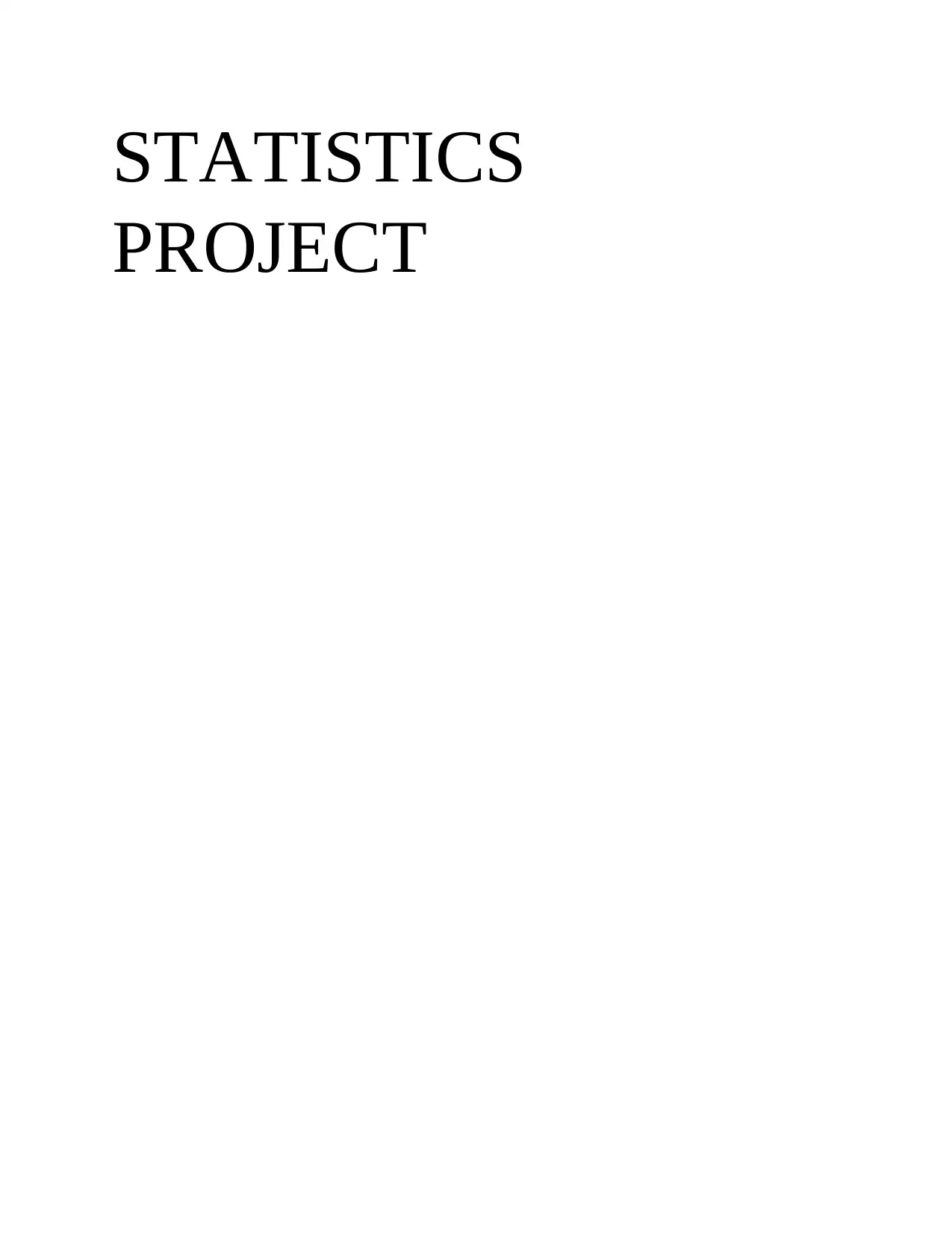
STATISTICS
PROJECT
PROJECT
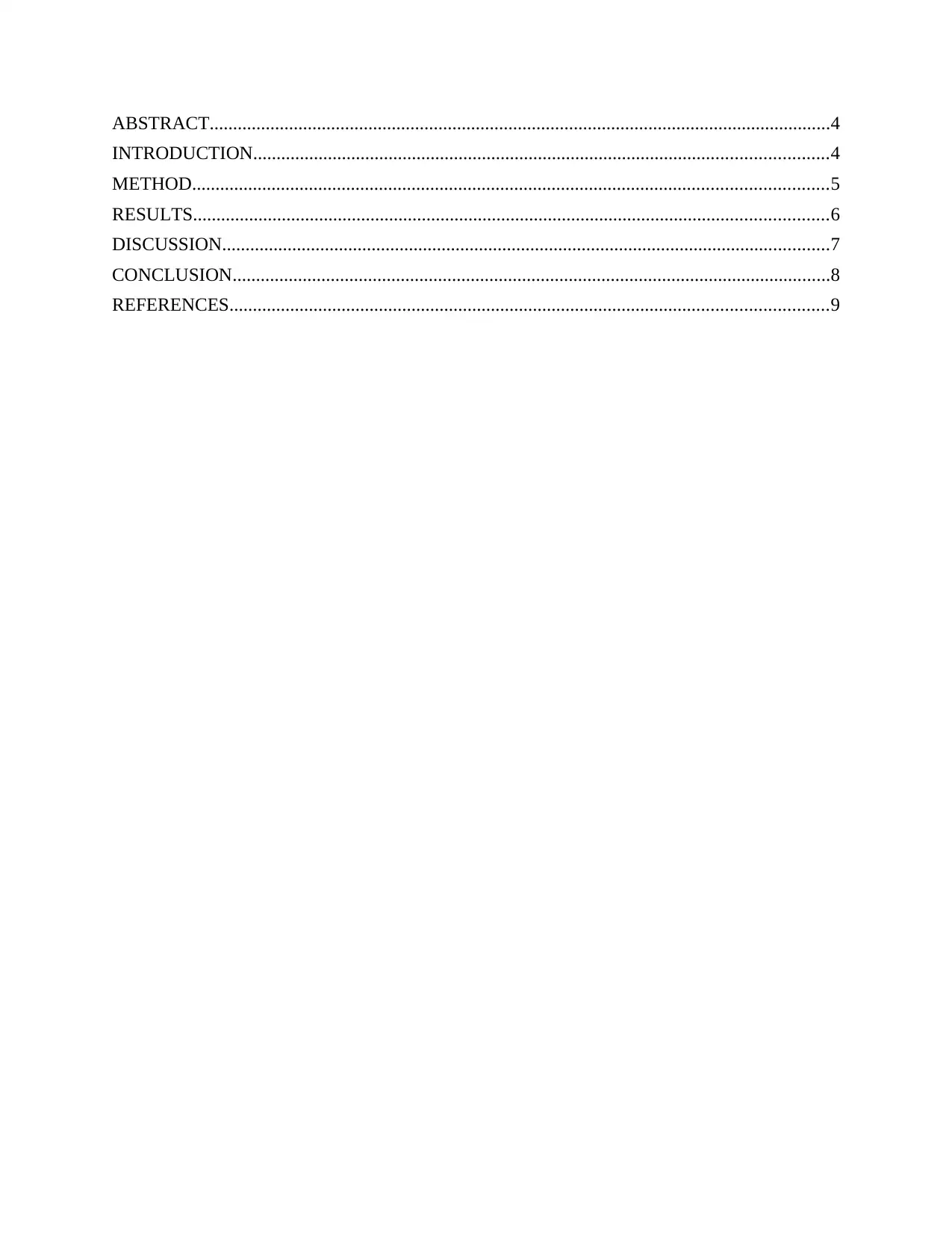
ABSTRACT.....................................................................................................................................4
INTRODUCTION...........................................................................................................................4
METHOD........................................................................................................................................5
RESULTS........................................................................................................................................6
DISCUSSION..................................................................................................................................7
CONCLUSION................................................................................................................................8
REFERENCES................................................................................................................................9
INTRODUCTION...........................................................................................................................4
METHOD........................................................................................................................................5
RESULTS........................................................................................................................................6
DISCUSSION..................................................................................................................................7
CONCLUSION................................................................................................................................8
REFERENCES................................................................................................................................9
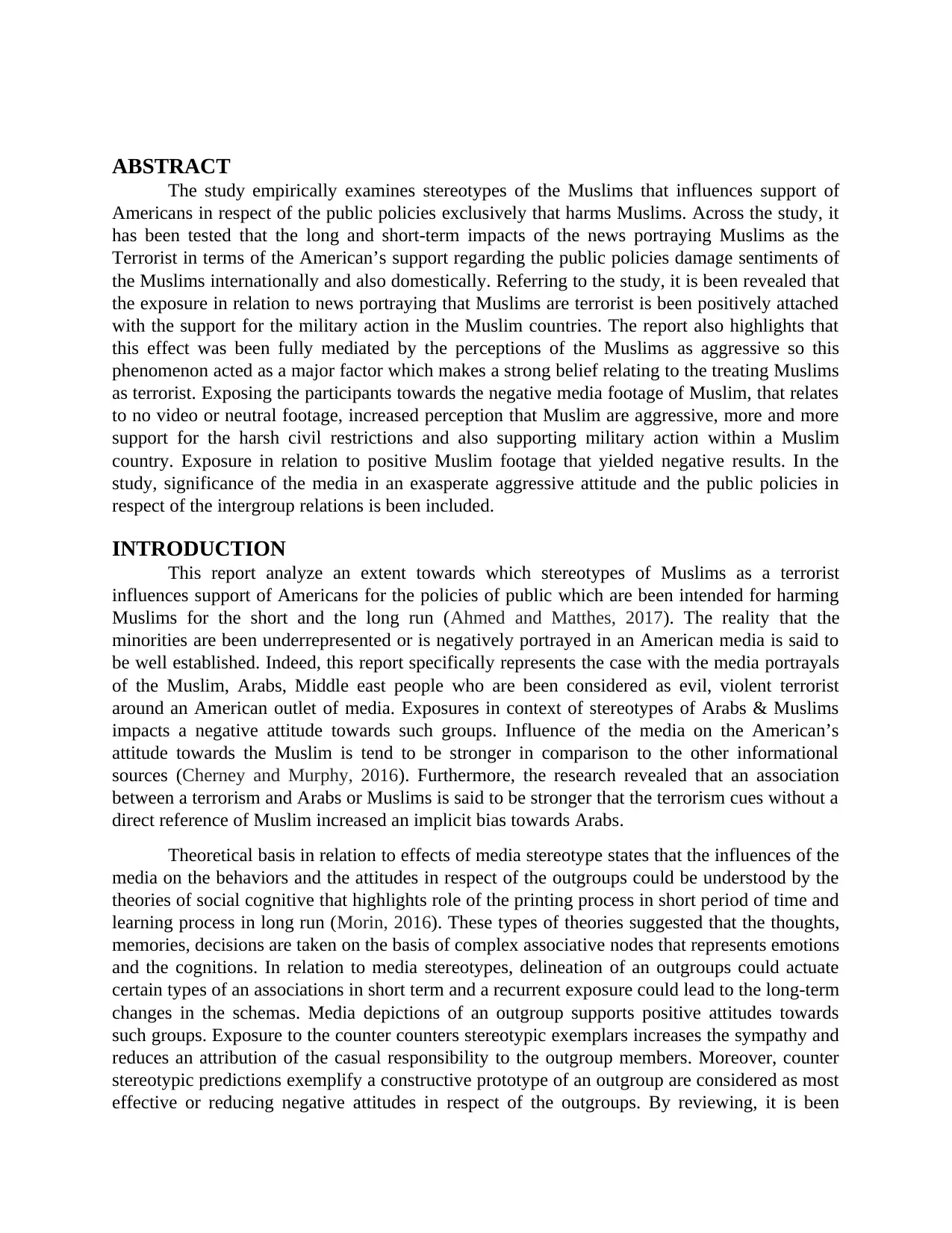
ABSTRACT
The study empirically examines stereotypes of the Muslims that influences support of
Americans in respect of the public policies exclusively that harms Muslims. Across the study, it
has been tested that the long and short-term impacts of the news portraying Muslims as the
Terrorist in terms of the American’s support regarding the public policies damage sentiments of
the Muslims internationally and also domestically. Referring to the study, it is been revealed that
the exposure in relation to news portraying that Muslims are terrorist is been positively attached
with the support for the military action in the Muslim countries. The report also highlights that
this effect was been fully mediated by the perceptions of the Muslims as aggressive so this
phenomenon acted as a major factor which makes a strong belief relating to the treating Muslims
as terrorist. Exposing the participants towards the negative media footage of Muslim, that relates
to no video or neutral footage, increased perception that Muslim are aggressive, more and more
support for the harsh civil restrictions and also supporting military action within a Muslim
country. Exposure in relation to positive Muslim footage that yielded negative results. In the
study, significance of the media in an exasperate aggressive attitude and the public policies in
respect of the intergroup relations is been included.
INTRODUCTION
This report analyze an extent towards which stereotypes of Muslims as a terrorist
influences support of Americans for the policies of public which are been intended for harming
Muslims for the short and the long run (Ahmed and Matthes, 2017). The reality that the
minorities are been underrepresented or is negatively portrayed in an American media is said to
be well established. Indeed, this report specifically represents the case with the media portrayals
of the Muslim, Arabs, Middle east people who are been considered as evil, violent terrorist
around an American outlet of media. Exposures in context of stereotypes of Arabs & Muslims
impacts a negative attitude towards such groups. Influence of the media on the American’s
attitude towards the Muslim is tend to be stronger in comparison to the other informational
sources (Cherney and Murphy, 2016). Furthermore, the research revealed that an association
between a terrorism and Arabs or Muslims is said to be stronger that the terrorism cues without a
direct reference of Muslim increased an implicit bias towards Arabs.
Theoretical basis in relation to effects of media stereotype states that the influences of the
media on the behaviors and the attitudes in respect of the outgroups could be understood by the
theories of social cognitive that highlights role of the printing process in short period of time and
learning process in long run (Morin, 2016). These types of theories suggested that the thoughts,
memories, decisions are taken on the basis of complex associative nodes that represents emotions
and the cognitions. In relation to media stereotypes, delineation of an outgroups could actuate
certain types of an associations in short term and a recurrent exposure could lead to the long-term
changes in the schemas. Media depictions of an outgroup supports positive attitudes towards
such groups. Exposure to the counter counters stereotypic exemplars increases the sympathy and
reduces an attribution of the casual responsibility to the outgroup members. Moreover, counter
stereotypic predictions exemplify a constructive prototype of an outgroup are considered as most
effective or reducing negative attitudes in respect of the outgroups. By reviewing, it is been
The study empirically examines stereotypes of the Muslims that influences support of
Americans in respect of the public policies exclusively that harms Muslims. Across the study, it
has been tested that the long and short-term impacts of the news portraying Muslims as the
Terrorist in terms of the American’s support regarding the public policies damage sentiments of
the Muslims internationally and also domestically. Referring to the study, it is been revealed that
the exposure in relation to news portraying that Muslims are terrorist is been positively attached
with the support for the military action in the Muslim countries. The report also highlights that
this effect was been fully mediated by the perceptions of the Muslims as aggressive so this
phenomenon acted as a major factor which makes a strong belief relating to the treating Muslims
as terrorist. Exposing the participants towards the negative media footage of Muslim, that relates
to no video or neutral footage, increased perception that Muslim are aggressive, more and more
support for the harsh civil restrictions and also supporting military action within a Muslim
country. Exposure in relation to positive Muslim footage that yielded negative results. In the
study, significance of the media in an exasperate aggressive attitude and the public policies in
respect of the intergroup relations is been included.
INTRODUCTION
This report analyze an extent towards which stereotypes of Muslims as a terrorist
influences support of Americans for the policies of public which are been intended for harming
Muslims for the short and the long run (Ahmed and Matthes, 2017). The reality that the
minorities are been underrepresented or is negatively portrayed in an American media is said to
be well established. Indeed, this report specifically represents the case with the media portrayals
of the Muslim, Arabs, Middle east people who are been considered as evil, violent terrorist
around an American outlet of media. Exposures in context of stereotypes of Arabs & Muslims
impacts a negative attitude towards such groups. Influence of the media on the American’s
attitude towards the Muslim is tend to be stronger in comparison to the other informational
sources (Cherney and Murphy, 2016). Furthermore, the research revealed that an association
between a terrorism and Arabs or Muslims is said to be stronger that the terrorism cues without a
direct reference of Muslim increased an implicit bias towards Arabs.
Theoretical basis in relation to effects of media stereotype states that the influences of the
media on the behaviors and the attitudes in respect of the outgroups could be understood by the
theories of social cognitive that highlights role of the printing process in short period of time and
learning process in long run (Morin, 2016). These types of theories suggested that the thoughts,
memories, decisions are taken on the basis of complex associative nodes that represents emotions
and the cognitions. In relation to media stereotypes, delineation of an outgroups could actuate
certain types of an associations in short term and a recurrent exposure could lead to the long-term
changes in the schemas. Media depictions of an outgroup supports positive attitudes towards
such groups. Exposure to the counter counters stereotypic exemplars increases the sympathy and
reduces an attribution of the casual responsibility to the outgroup members. Moreover, counter
stereotypic predictions exemplify a constructive prototype of an outgroup are considered as most
effective or reducing negative attitudes in respect of the outgroups. By reviewing, it is been
Secure Best Marks with AI Grader
Need help grading? Try our AI Grader for instant feedback on your assignments.
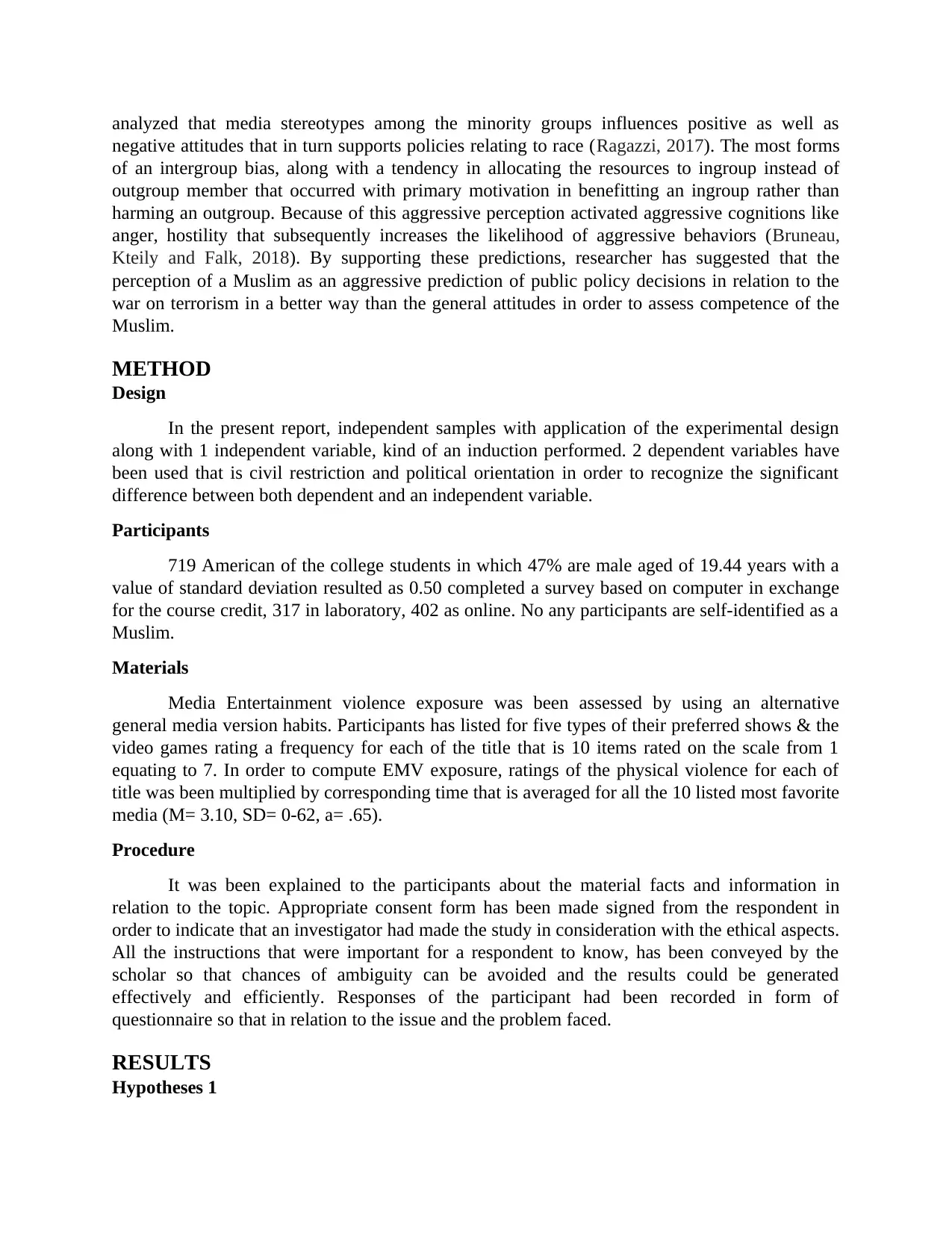
analyzed that media stereotypes among the minority groups influences positive as well as
negative attitudes that in turn supports policies relating to race (Ragazzi, 2017). The most forms
of an intergroup bias, along with a tendency in allocating the resources to ingroup instead of
outgroup member that occurred with primary motivation in benefitting an ingroup rather than
harming an outgroup. Because of this aggressive perception activated aggressive cognitions like
anger, hostility that subsequently increases the likelihood of aggressive behaviors (Bruneau,
Kteily and Falk, 2018). By supporting these predictions, researcher has suggested that the
perception of a Muslim as an aggressive prediction of public policy decisions in relation to the
war on terrorism in a better way than the general attitudes in order to assess competence of the
Muslim.
METHOD
Design
In the present report, independent samples with application of the experimental design
along with 1 independent variable, kind of an induction performed. 2 dependent variables have
been used that is civil restriction and political orientation in order to recognize the significant
difference between both dependent and an independent variable.
Participants
719 American of the college students in which 47% are male aged of 19.44 years with a
value of standard deviation resulted as 0.50 completed a survey based on computer in exchange
for the course credit, 317 in laboratory, 402 as online. No any participants are self-identified as a
Muslim.
Materials
Media Entertainment violence exposure was been assessed by using an alternative
general media version habits. Participants has listed for five types of their preferred shows & the
video games rating a frequency for each of the title that is 10 items rated on the scale from 1
equating to 7. In order to compute EMV exposure, ratings of the physical violence for each of
title was been multiplied by corresponding time that is averaged for all the 10 listed most favorite
media (M= 3.10, SD= 0-62, a= .65).
Procedure
It was been explained to the participants about the material facts and information in
relation to the topic. Appropriate consent form has been made signed from the respondent in
order to indicate that an investigator had made the study in consideration with the ethical aspects.
All the instructions that were important for a respondent to know, has been conveyed by the
scholar so that chances of ambiguity can be avoided and the results could be generated
effectively and efficiently. Responses of the participant had been recorded in form of
questionnaire so that in relation to the issue and the problem faced.
RESULTS
Hypotheses 1
negative attitudes that in turn supports policies relating to race (Ragazzi, 2017). The most forms
of an intergroup bias, along with a tendency in allocating the resources to ingroup instead of
outgroup member that occurred with primary motivation in benefitting an ingroup rather than
harming an outgroup. Because of this aggressive perception activated aggressive cognitions like
anger, hostility that subsequently increases the likelihood of aggressive behaviors (Bruneau,
Kteily and Falk, 2018). By supporting these predictions, researcher has suggested that the
perception of a Muslim as an aggressive prediction of public policy decisions in relation to the
war on terrorism in a better way than the general attitudes in order to assess competence of the
Muslim.
METHOD
Design
In the present report, independent samples with application of the experimental design
along with 1 independent variable, kind of an induction performed. 2 dependent variables have
been used that is civil restriction and political orientation in order to recognize the significant
difference between both dependent and an independent variable.
Participants
719 American of the college students in which 47% are male aged of 19.44 years with a
value of standard deviation resulted as 0.50 completed a survey based on computer in exchange
for the course credit, 317 in laboratory, 402 as online. No any participants are self-identified as a
Muslim.
Materials
Media Entertainment violence exposure was been assessed by using an alternative
general media version habits. Participants has listed for five types of their preferred shows & the
video games rating a frequency for each of the title that is 10 items rated on the scale from 1
equating to 7. In order to compute EMV exposure, ratings of the physical violence for each of
title was been multiplied by corresponding time that is averaged for all the 10 listed most favorite
media (M= 3.10, SD= 0-62, a= .65).
Procedure
It was been explained to the participants about the material facts and information in
relation to the topic. Appropriate consent form has been made signed from the respondent in
order to indicate that an investigator had made the study in consideration with the ethical aspects.
All the instructions that were important for a respondent to know, has been conveyed by the
scholar so that chances of ambiguity can be avoided and the results could be generated
effectively and efficiently. Responses of the participant had been recorded in form of
questionnaire so that in relation to the issue and the problem faced.
RESULTS
Hypotheses 1
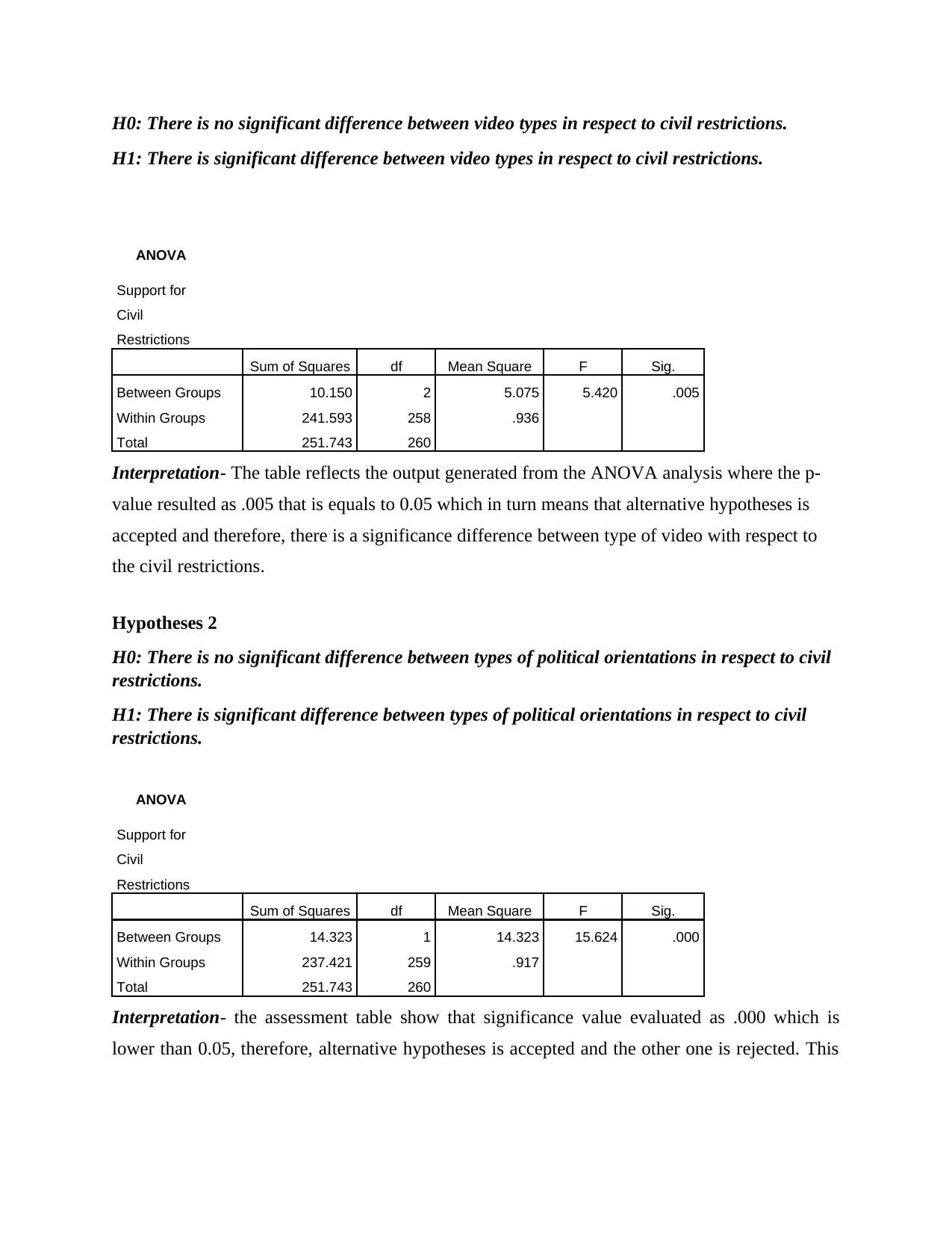
H0: There is no significant difference between video types in respect to civil restrictions.
H1: There is significant difference between video types in respect to civil restrictions.
ANOVA
Support for
Civil
Restrictions
Sum of Squares df Mean Square F Sig.
Between Groups 10.150 2 5.075 5.420 .005
Within Groups 241.593 258 .936
Total 251.743 260
Interpretation- The table reflects the output generated from the ANOVA analysis where the p-
value resulted as .005 that is equals to 0.05 which in turn means that alternative hypotheses is
accepted and therefore, there is a significance difference between type of video with respect to
the civil restrictions.
Hypotheses 2
H0: There is no significant difference between types of political orientations in respect to civil
restrictions.
H1: There is significant difference between types of political orientations in respect to civil
restrictions.
ANOVA
Support for
Civil
Restrictions
Sum of Squares df Mean Square F Sig.
Between Groups 14.323 1 14.323 15.624 .000
Within Groups 237.421 259 .917
Total 251.743 260
Interpretation- the assessment table show that significance value evaluated as .000 which is
lower than 0.05, therefore, alternative hypotheses is accepted and the other one is rejected. This
H1: There is significant difference between video types in respect to civil restrictions.
ANOVA
Support for
Civil
Restrictions
Sum of Squares df Mean Square F Sig.
Between Groups 10.150 2 5.075 5.420 .005
Within Groups 241.593 258 .936
Total 251.743 260
Interpretation- The table reflects the output generated from the ANOVA analysis where the p-
value resulted as .005 that is equals to 0.05 which in turn means that alternative hypotheses is
accepted and therefore, there is a significance difference between type of video with respect to
the civil restrictions.
Hypotheses 2
H0: There is no significant difference between types of political orientations in respect to civil
restrictions.
H1: There is significant difference between types of political orientations in respect to civil
restrictions.
ANOVA
Support for
Civil
Restrictions
Sum of Squares df Mean Square F Sig.
Between Groups 14.323 1 14.323 15.624 .000
Within Groups 237.421 259 .917
Total 251.743 260
Interpretation- the assessment table show that significance value evaluated as .000 which is
lower than 0.05, therefore, alternative hypotheses is accepted and the other one is rejected. This
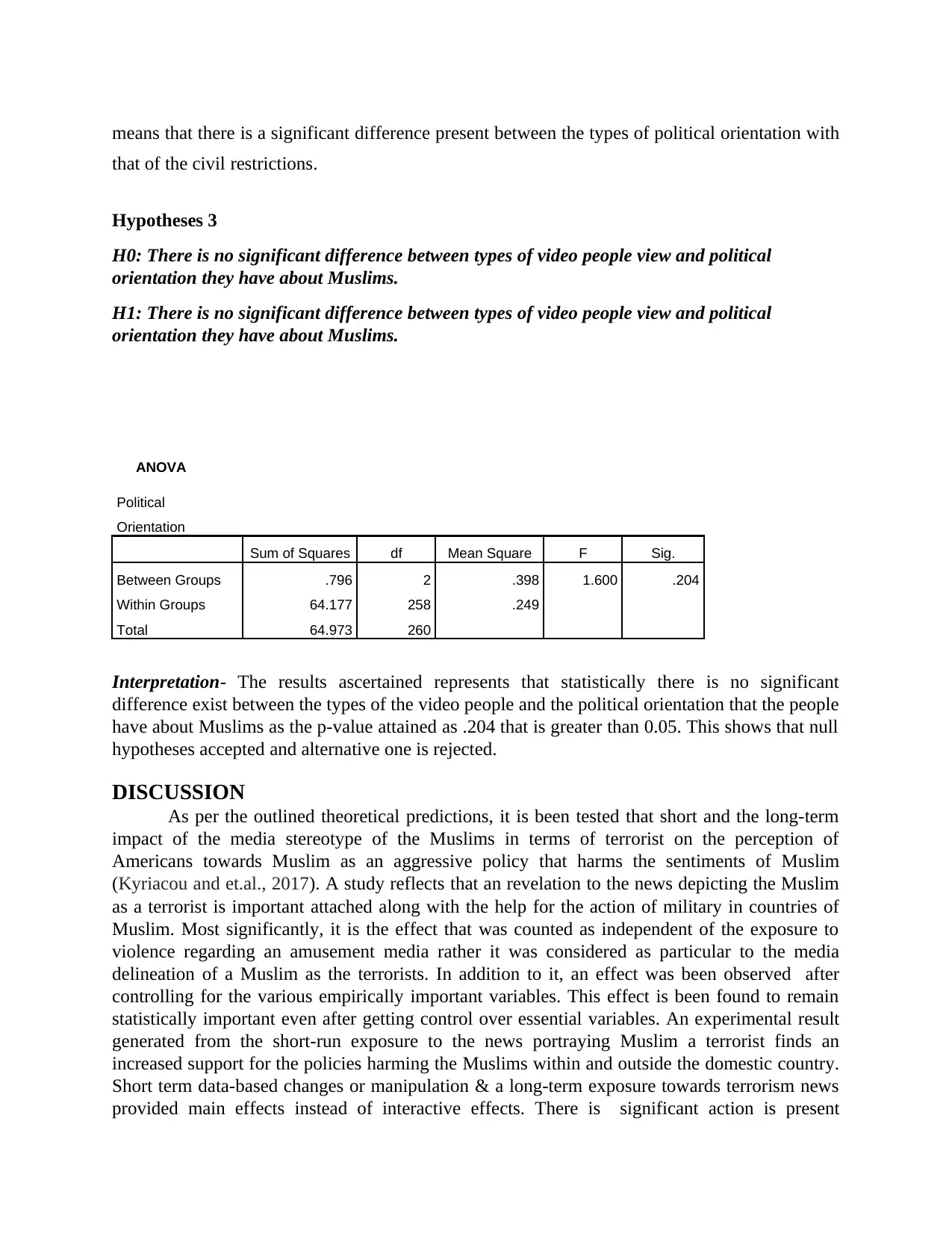
means that there is a significant difference present between the types of political orientation with
that of the civil restrictions.
Hypotheses 3
H0: There is no significant difference between types of video people view and political
orientation they have about Muslims.
H1: There is no significant difference between types of video people view and political
orientation they have about Muslims.
ANOVA
Political
Orientation
Sum of Squares df Mean Square F Sig.
Between Groups .796 2 .398 1.600 .204
Within Groups 64.177 258 .249
Total 64.973 260
Interpretation- The results ascertained represents that statistically there is no significant
difference exist between the types of the video people and the political orientation that the people
have about Muslims as the p-value attained as .204 that is greater than 0.05. This shows that null
hypotheses accepted and alternative one is rejected.
DISCUSSION
As per the outlined theoretical predictions, it is been tested that short and the long-term
impact of the media stereotype of the Muslims in terms of terrorist on the perception of
Americans towards Muslim as an aggressive policy that harms the sentiments of Muslim
(Kyriacou and et.al., 2017). A study reflects that an revelation to the news depicting the Muslim
as a terrorist is important attached along with the help for the action of military in countries of
Muslim. Most significantly, it is the effect that was counted as independent of the exposure to
violence regarding an amusement media rather it was considered as particular to the media
delineation of a Muslim as the terrorists. In addition to it, an effect was been observed after
controlling for the various empirically important variables. This effect is been found to remain
statistically important even after getting control over essential variables. An experimental result
generated from the short-run exposure to the news portraying Muslim a terrorist finds an
increased support for the policies harming the Muslims within and outside the domestic country.
Short term data-based changes or manipulation & a long-term exposure towards terrorism news
provided main effects instead of interactive effects. There is significant action is present
that of the civil restrictions.
Hypotheses 3
H0: There is no significant difference between types of video people view and political
orientation they have about Muslims.
H1: There is no significant difference between types of video people view and political
orientation they have about Muslims.
ANOVA
Political
Orientation
Sum of Squares df Mean Square F Sig.
Between Groups .796 2 .398 1.600 .204
Within Groups 64.177 258 .249
Total 64.973 260
Interpretation- The results ascertained represents that statistically there is no significant
difference exist between the types of the video people and the political orientation that the people
have about Muslims as the p-value attained as .204 that is greater than 0.05. This shows that null
hypotheses accepted and alternative one is rejected.
DISCUSSION
As per the outlined theoretical predictions, it is been tested that short and the long-term
impact of the media stereotype of the Muslims in terms of terrorist on the perception of
Americans towards Muslim as an aggressive policy that harms the sentiments of Muslim
(Kyriacou and et.al., 2017). A study reflects that an revelation to the news depicting the Muslim
as a terrorist is important attached along with the help for the action of military in countries of
Muslim. Most significantly, it is the effect that was counted as independent of the exposure to
violence regarding an amusement media rather it was considered as particular to the media
delineation of a Muslim as the terrorists. In addition to it, an effect was been observed after
controlling for the various empirically important variables. This effect is been found to remain
statistically important even after getting control over essential variables. An experimental result
generated from the short-run exposure to the news portraying Muslim a terrorist finds an
increased support for the policies harming the Muslims within and outside the domestic country.
Short term data-based changes or manipulation & a long-term exposure towards terrorism news
provided main effects instead of interactive effects. There is significant action is present
Paraphrase This Document
Need a fresh take? Get an instant paraphrase of this document with our AI Paraphraser
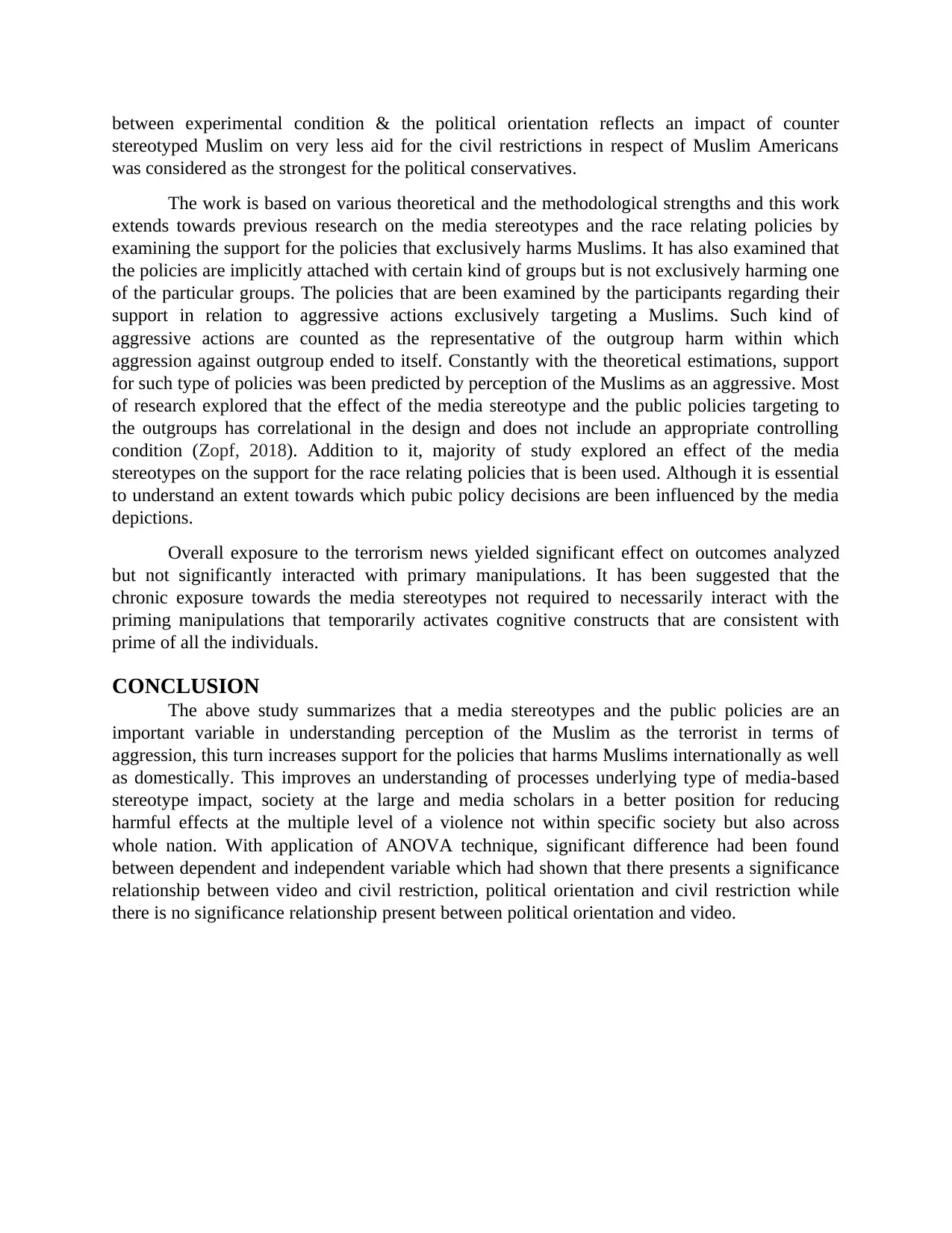
between experimental condition & the political orientation reflects an impact of counter
stereotyped Muslim on very less aid for the civil restrictions in respect of Muslim Americans
was considered as the strongest for the political conservatives.
The work is based on various theoretical and the methodological strengths and this work
extends towards previous research on the media stereotypes and the race relating policies by
examining the support for the policies that exclusively harms Muslims. It has also examined that
the policies are implicitly attached with certain kind of groups but is not exclusively harming one
of the particular groups. The policies that are been examined by the participants regarding their
support in relation to aggressive actions exclusively targeting a Muslims. Such kind of
aggressive actions are counted as the representative of the outgroup harm within which
aggression against outgroup ended to itself. Constantly with the theoretical estimations, support
for such type of policies was been predicted by perception of the Muslims as an aggressive. Most
of research explored that the effect of the media stereotype and the public policies targeting to
the outgroups has correlational in the design and does not include an appropriate controlling
condition (Zopf, 2018). Addition to it, majority of study explored an effect of the media
stereotypes on the support for the race relating policies that is been used. Although it is essential
to understand an extent towards which pubic policy decisions are been influenced by the media
depictions.
Overall exposure to the terrorism news yielded significant effect on outcomes analyzed
but not significantly interacted with primary manipulations. It has been suggested that the
chronic exposure towards the media stereotypes not required to necessarily interact with the
priming manipulations that temporarily activates cognitive constructs that are consistent with
prime of all the individuals.
CONCLUSION
The above study summarizes that a media stereotypes and the public policies are an
important variable in understanding perception of the Muslim as the terrorist in terms of
aggression, this turn increases support for the policies that harms Muslims internationally as well
as domestically. This improves an understanding of processes underlying type of media-based
stereotype impact, society at the large and media scholars in a better position for reducing
harmful effects at the multiple level of a violence not within specific society but also across
whole nation. With application of ANOVA technique, significant difference had been found
between dependent and independent variable which had shown that there presents a significance
relationship between video and civil restriction, political orientation and civil restriction while
there is no significance relationship present between political orientation and video.
stereotyped Muslim on very less aid for the civil restrictions in respect of Muslim Americans
was considered as the strongest for the political conservatives.
The work is based on various theoretical and the methodological strengths and this work
extends towards previous research on the media stereotypes and the race relating policies by
examining the support for the policies that exclusively harms Muslims. It has also examined that
the policies are implicitly attached with certain kind of groups but is not exclusively harming one
of the particular groups. The policies that are been examined by the participants regarding their
support in relation to aggressive actions exclusively targeting a Muslims. Such kind of
aggressive actions are counted as the representative of the outgroup harm within which
aggression against outgroup ended to itself. Constantly with the theoretical estimations, support
for such type of policies was been predicted by perception of the Muslims as an aggressive. Most
of research explored that the effect of the media stereotype and the public policies targeting to
the outgroups has correlational in the design and does not include an appropriate controlling
condition (Zopf, 2018). Addition to it, majority of study explored an effect of the media
stereotypes on the support for the race relating policies that is been used. Although it is essential
to understand an extent towards which pubic policy decisions are been influenced by the media
depictions.
Overall exposure to the terrorism news yielded significant effect on outcomes analyzed
but not significantly interacted with primary manipulations. It has been suggested that the
chronic exposure towards the media stereotypes not required to necessarily interact with the
priming manipulations that temporarily activates cognitive constructs that are consistent with
prime of all the individuals.
CONCLUSION
The above study summarizes that a media stereotypes and the public policies are an
important variable in understanding perception of the Muslim as the terrorist in terms of
aggression, this turn increases support for the policies that harms Muslims internationally as well
as domestically. This improves an understanding of processes underlying type of media-based
stereotype impact, society at the large and media scholars in a better position for reducing
harmful effects at the multiple level of a violence not within specific society but also across
whole nation. With application of ANOVA technique, significant difference had been found
between dependent and independent variable which had shown that there presents a significance
relationship between video and civil restriction, political orientation and civil restriction while
there is no significance relationship present between political orientation and video.
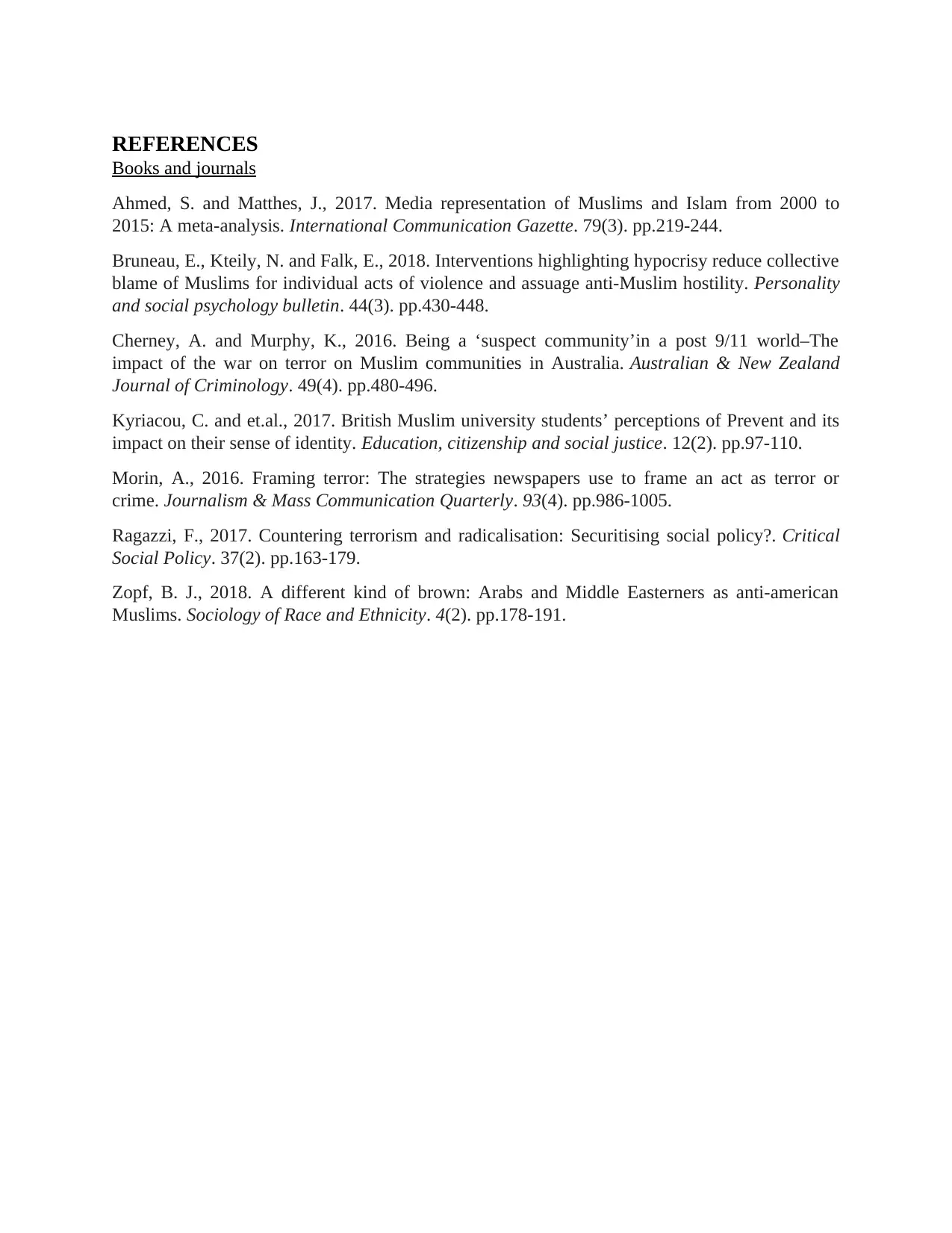
REFERENCES
Books and journals
Ahmed, S. and Matthes, J., 2017. Media representation of Muslims and Islam from 2000 to
2015: A meta-analysis. International Communication Gazette. 79(3). pp.219-244.
Bruneau, E., Kteily, N. and Falk, E., 2018. Interventions highlighting hypocrisy reduce collective
blame of Muslims for individual acts of violence and assuage anti-Muslim hostility. Personality
and social psychology bulletin. 44(3). pp.430-448.
Cherney, A. and Murphy, K., 2016. Being a ‘suspect community’in a post 9/11 world–The
impact of the war on terror on Muslim communities in Australia. Australian & New Zealand
Journal of Criminology. 49(4). pp.480-496.
Kyriacou, C. and et.al., 2017. British Muslim university students’ perceptions of Prevent and its
impact on their sense of identity. Education, citizenship and social justice. 12(2). pp.97-110.
Morin, A., 2016. Framing terror: The strategies newspapers use to frame an act as terror or
crime. Journalism & Mass Communication Quarterly. 93(4). pp.986-1005.
Ragazzi, F., 2017. Countering terrorism and radicalisation: Securitising social policy?. Critical
Social Policy. 37(2). pp.163-179.
Zopf, B. J., 2018. A different kind of brown: Arabs and Middle Easterners as anti-american
Muslims. Sociology of Race and Ethnicity. 4(2). pp.178-191.
Books and journals
Ahmed, S. and Matthes, J., 2017. Media representation of Muslims and Islam from 2000 to
2015: A meta-analysis. International Communication Gazette. 79(3). pp.219-244.
Bruneau, E., Kteily, N. and Falk, E., 2018. Interventions highlighting hypocrisy reduce collective
blame of Muslims for individual acts of violence and assuage anti-Muslim hostility. Personality
and social psychology bulletin. 44(3). pp.430-448.
Cherney, A. and Murphy, K., 2016. Being a ‘suspect community’in a post 9/11 world–The
impact of the war on terror on Muslim communities in Australia. Australian & New Zealand
Journal of Criminology. 49(4). pp.480-496.
Kyriacou, C. and et.al., 2017. British Muslim university students’ perceptions of Prevent and its
impact on their sense of identity. Education, citizenship and social justice. 12(2). pp.97-110.
Morin, A., 2016. Framing terror: The strategies newspapers use to frame an act as terror or
crime. Journalism & Mass Communication Quarterly. 93(4). pp.986-1005.
Ragazzi, F., 2017. Countering terrorism and radicalisation: Securitising social policy?. Critical
Social Policy. 37(2). pp.163-179.
Zopf, B. J., 2018. A different kind of brown: Arabs and Middle Easterners as anti-american
Muslims. Sociology of Race and Ethnicity. 4(2). pp.178-191.
1 out of 9
Related Documents
Your All-in-One AI-Powered Toolkit for Academic Success.
+13062052269
info@desklib.com
Available 24*7 on WhatsApp / Email
![[object Object]](/_next/static/media/star-bottom.7253800d.svg)
Unlock your academic potential
© 2024 | Zucol Services PVT LTD | All rights reserved.
